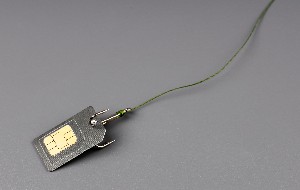Table of contents
- 1. Enable fingerprint security on the mobile Gmail app
- 2. Choose a strong password to protect Gmail on Android phone
- 3. Update the Gmail app on your Android phone
- 4. Manage Gmail security settings
- Conclusion
1. Enable fingerprint security on the mobile Gmail app
Modern smartphones ship with biometric security features, such as fingerprint scanners, and they’re there for a reason. They don’t just make unlocking your phone more convenient; they’re also significantly more secure than using a passcode or PIN unlock alone.
Unfortunately, Google doesn’t allow us to lock and unlock the Gmail app with a fingerprint by default, but you can add this functionality on your Android device using a third-party app, such as AppLock. You can download it for free from the Google Play Store.
Tip
With AppLock, you can add Gmail to your list of protected applications. You can then select your fingerprint as an unlock method. Whenever Gmail is opened, AppLock will prevent it from being used until your fingerprint is scanned.
2. Choose a strong password to protect Gmail on Android phone
Never use the same password for multiple accounts—this will only make it easier for hackers to gain access to more of your data. To protect Gmail on an Android phone, all passwords for all your accounts should be strong and unique, not easily guessable things like your name or favorite sports team.
Tip
A strong password contains a combination of uppercase and lowercase letters, numbers, and symbols (except for those that include accents). It should also be at least 12 characters long, and the more the better. Avoid common passwords like “password123” or names of people who are close to you.
3. Update the Gmail app on your Android phone
Apart from unlocking awesome new features, updates will help you protect yourself from viruses and spyware. Can phones get viruses? Absolutely, but keeping Gmail and your other apps up to date helps minimize that risk by installing the latest security patches.
Installing the latest Gmail update on your Android device is simple. Just follow these steps:
- Open the Google Play Store on your device
- Tap your avatar in the top-left corner, then tap Manage apps and devices
- Under Updates available, tap Update all.
If you’re worried about hackers exploiting your apps, you can increase your protection with Clario AntiSpy. One of the most common ways that hackers will steal your personal information is by using spyware to monitor all your activities. Here’s how you can stop it:
- Install Clario AntiSpy for Android and scan your device for hidden spyware
- Enable the data breach monitor to get alerts if your data is ever leaked
- Follow the cybersecurity tips inside the app to stay safe.
Tip
Did you know there are codes you can enter on your phone to find out if it may be tapped? You just need to know what to dial to see if your phone is hacked.
4. Manage Gmail security settings
Review the security settings for your account to ensure you’re using the recommended security for Gmail on Android and to identify any potential issues. To do this, you’ll need to open Gmail in a web browser, as not all security settings are available inside the Gmail app.
To manage the security settings of your Gmail account, follow these steps:
- Open Gmail in your web browser
- In the top-right corner, tap Settings, then See all settings
- Check the following tabs to review your settings:
- General tab
- Accounts and import tab
- Filters and blocked addresses tab
- Forwarding POP/IMAP tab
- Ensure all options are set as you prefer them and that there are no issues.
Google recommends that you pay close attention to the following under each tab:
| General tab |
|
| Accounts and Import tab |
|
| Filters and Blocked Addresses tab |
|
| Forwarding and POP/IMAP tab |
|
Conclusion
You can’t avoid using email these days, and it’s impossible to keep your Gmail inbox completely free from personal information. But you can take some simple precautions to ensure your Gmail app is secure, free from potential security risks, and using the best safety protections. This will help keep your private data private.
It’s also a good idea to keep your email inbox as clean as possible, making it easier to identify suspicious messages. Research how to block unwanted emails, and in case you fall victim to account breaches, be prepared for what to do if your email is hacked.


